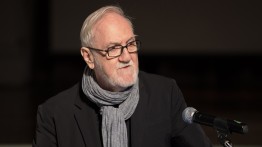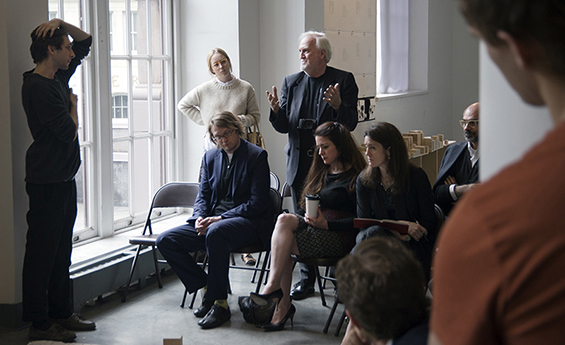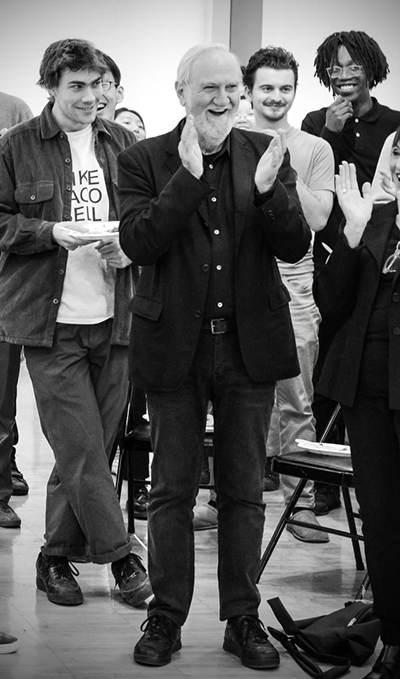Anthony Vidler - In Memoriam
POSTED ON: October 20, 2023

Dear Members of the Cooper Union Community:
It is with a heavy heart that I write bearing the somber news of the passing of Professor and former Dean of the School of Architecture Anthony Vidler. The Cooper Union joins the field of Architecture in grieving the loss of a most brilliant intellect and tirelessly creative spirit. We are deeply saddened by the departure of a cherished friend justly celebrated for his boundless generosity, wit, and unquenchable optimism.
From 2001 to 2013, Tony took on the formidable role of Dean of The Irwin S. Chanin School of Architecture following in the footsteps of John Hejduk‘s remarkable twenty-five-year tenure. In Tony, we found a wholly devoted advocate for the discipline as well as the profession of architecture, an unwavering intellect, and a fervent believer in the potential of architecture to impact culture, society, and the shaping of history. His profound understanding of and appreciation for the School's culture and ethos predated his arrival as Dean and was subsequently demonstrated by his nuanced ability to honor our history without being constrained by it.

As Dean, Tony championed our pedagogical project, enhancing and expanding its long-standing commitment to exploring the interplay between history, theory, design, and methods of architectural representation. He played a pivotal role in establishing the post-professional degree program and consistently worked to broaden the school’s engagement, connecting it more deeply with New York City and beyond. Tony also led the way in integrating emerging technologies while underscoring the enduring value of traditional hand-drawing and modeling. He was an indefatigable advocate for the faculty and a generous colleague, offering mentorship and support, and launching numerous academic careers.

Tony was an exceptional historian and a uniquely gifted thinker. His early work on the architecture and architectural theory of the French Enlightenment is unparalleled: this performance of fine-grained archival research brought to life by the quality of his writing lured many a young architect into the pleasures of architectural history and theory. Over 50 years of teaching, research, and writing, he became one of the most influential observers and interpreters of both architectural historiography and contemporary architecture. As a faculty member, he was an intellectual powerhouse and a wellspring of inspiration. His teaching spanned a spectrum from the first-semester Introduction to the History of Architecture and Introduction to Urban Histories and Theories to thought-provoking seminars such as "Theorizing the Urban: Polis, Metropolis, Megalopolis,” "The Critical Edge: Walter Benjamin and the Arts of Modernity," and “Countrysides: Extraction, Exploitation, Representation from the Renaissance to the Present.”
As designer and curator, Tony installed the permanent exhibition of the work of Claude-Nicolas Ledoux in the Royal Salt Works of Arc-et-Senans in Franche-Comté, France, as well as curating the exhibition, “Ledoux et les Lumières” at Arc-et-Senans for the European year of Enlightenment. In 2004 he was asked to curate the portion of the exhibition “Out of the Box” dedicated to James Stirling, for the Canadian Center of Architecture, Montreal, and in 2010 installed the exhibition “Notes from the Archive: James Frazer Stirling,” in the Yale Centre for British Art, an exhibition that then travelled to the Tate Britain and the Staatsgalerie, Stuttgart in 2011.
His publications include The Writing of the Walls: Architectural Theory in the Late Enlightenment; Claude-Nicolas Ledoux: Architecture and Social Reform at the End of the Ancien Regime which received the Henry-Russell Hitchcock Award from the Society of Architectural Historians; The Architectural Uncanny: Essays in the Modern Unhomely; Warped Space: Architecture and Anxiety in Modern Culture; Histories of the Immediate Present: The Invention of Architectural Modernism; James Frazer Stirling: Notes from the Archive; and The Scenes of the Street and other Essays. He was a Fellow of the American Academy of Arts and Sciences and received the architecture award from the American Academy of Arts and Letters in 2011.

Tony taught 55 courses and design studios in the School of Architecture between 2003 and 2023. I had the privilege of co-teaching Thesis with him for many years and found him to be an insightful design critic, creating the most beautiful sketches in his notebook, with an encyclopedic mind, a great sense of humor, and an incredible knack for imitating accents. The pleasures of his intellect were matched, after hours, by his warmth, his talents as a host and chef, his discerning palate for scotch and fine wines, his keen interest in photography, and his perennial enthusiasm for the newest gadgets.
In reflecting on his deanship of the School of Architecture at the time he stepped down from that position, Tony stated: My identity has never been caught up in being Dean or Chair or Director of Programs. I have always felt that it simply allowed me to get closer to the students and faculty and to work more collectively than as an individual faculty member. One of the things I have really enjoyed about the Cooper Union School of Architecture is that it has a governance that is completely democratic. Out of the Student Council there is a voting student member on every single committee as well as two adjunct members and two full-time members. So the school is represented on every front. For me it’s a perfect little social institution. I hope that it will be seen that we emerged in the 21st Century with the kind of tools and expertise in terms of faculty and resources that will equip students to face the serious questions that the present environment and urban conditions pose to design.
Tony infused every meeting, committee, lecture hall and design review with a uniquely youthful curiosity and a contagious intellectual vigor. It is impossible to imagine these halls and this world without him.
With profound sadness,
Hayley Eber




